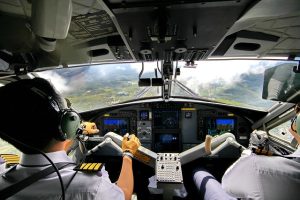
Of all the different controls in a typical airplane’s cockpit, few are as important as the control yoke. It’s the equivalent of a steering wheel in a car or truck. Pilots can essentially steer and change the airplane’s direction by moving the yoke. To learn more about aircraft yokes, keep reading.
#1) Also Known as Control Wheels
Control yokes are also known as control wheels. They don’t necessarily look like wheels. Rather, control yokes are available in different styles, each of which has its own unique shape and appearance. Because they serve as the main control mechanism for pitch and roll, however, they are commonly referred to as control wheels.
#2) Controls Ailerons
Control yokes are used to control the ailerons on an airplane. Ailerons are hinge-like control surfaces on the trailing edges of an airplane’s wings. They allow pilots to roll the airplane and, thus, turn in a particular direction. Turning the yoke to the right will engage the ailerons and, thus, roll the airplane in that direction.
#3) Used to Change Altitude
Pilots use control yokes to change the altitude when flying. Pulling the yoke back will result in the nose of the airplane rising. Pushing the yoke forward, conversely, will result in the nose of the airplane lowering.
#4) U, W and M Styles
Not all control yokes are the same. They are available in several styles, some of the most common of which are U, W and M. Each of these three styles represents its respective shape. U-style yokes, for instance, are shaped like the letter U, whereas W-style yokes are shaped like the letter W. U and W are the most common yoke styles, but some airplanes use an M-style yoke.
#5) May Feature a Stick Shaker
It’s not uncommon for control yokes to feature a stick shaker. This optional control feature is designed to assist with the onset of the stalls. If an airplane is beginning to stall, the stick shaker will live up to its namesake by “shaking” the yoke stick. The purpose of a stick shaker is to alert the pilot about the stall so that he or she can take corrective action.
#6) Equipped With Buttons
In addition to a stick shaker, control yokes may feature various buttons. Some of them have finger buttons for a radio, for instance. Pilots can press these buttons to activate the airplane’s radio. Other yokes have finger buttons for the autopilot. Pilots can engage or disengage the autopilot by pressing these buttons.



